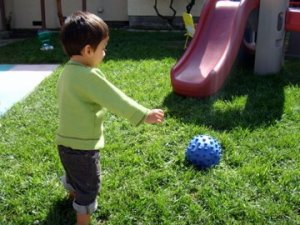After reading about motor learning, you are on your way to having a basic understanding of the puzzle of what actually takes place before a ball is kicked or before first steps are taken. Execution of a motor skill requires several pieces of the puzzle to come together. Another piece of the puzzle is motor control.
Motor control is a broad term used to describe the nervous system’s abilitiy to regulate the timing and amount of muscle contraction to produce smooth, coordinated, fine and gross movements. Like motor learning, this occurs in three stages. The first stage is stimulus indentification. In this stage, important sesnory stimuli from the environment as well as from the body itself (input from prioprioceptors in the joints and muscles that tell our brain where our body is relative to it’s space) are identified. While several stimuli may be present, only certain ones are relevant and necessary to lead to motor production. Previous experience, attention, motivation, and emotional state can all be factors in the ability to regulate sensory input. Children with neurological impairments as in Cerebral Palsy or or with sensory processing difficulties as in Autism will most likely have difficulty progressing past this stage. Initially, they may require a controlled environment along with sensory integration training in which they learn to regulate different stimuli before they can be expected to execute the desired movement appropriately.
The second stage is the response selection stage. During this stage, a purposeful motor plan is developed and a general decision is made. For example, when you are driving you see a red light (visual sensory input is identified) and in response you move your foot to the brake pedal to stop your vehicle (response selection). This is an easy decision. However, in the case of a yellow light you identify the stimulus but you may hesitate in your response between braking or continuing on but ultimately you are still able to choose an appropriate response. Unfortunately, if your neuromuscular system is impaired, you may be unable to produce a purposeful movement in response to a stimuli or you may produce the same movement in response to every stimuli or your responses may be too little or too much related to the stimulus.
The third stage is response programming. In this final stage, control centers in our brain begin to program the sequence of muscular actions that occured in response to a certain stimuli so that we now have the response programmed in our brain to access whenever we need to. This is why for most of us, braking and accelerating in response to traffic lights hardly requires any thought or effort. It just happens. As pediatric therapists, we strive to help children with various types of impairments achieve this stage of motor control.
The progression of motor control is very similar to that of motor learning. However, it may help to think of motor control as the first piece to the puzzle and motor learning the second. You must be able to produce smooth, coordinated, sequenced movements before you can truly become autonomous with any skill.
Hopefully, these articles are helping you to understand the processes behind motor execution.

Fantastic explanation! Thanks for sharing!
Comment by Little Hands Love Big — November 15, 2012 @ 12:33 pm |